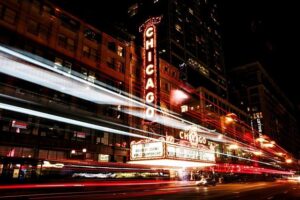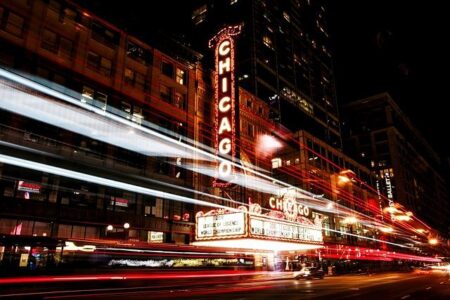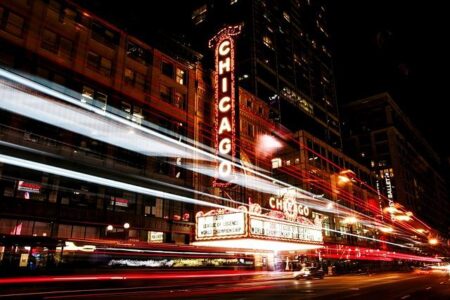If you’ve traveled along Chicago’s famous Lakeshore Drive at any point in the last few years, then you might have seen a bit of a strange sight. Right where the expressway skirting Lake Michigan crosses the Chicago River, a huge gaping hole has been just sitting there virtually unchanged for well over a decade.
It was supposed to be the start of America’s first megat skyscraper designed by one of the world’s leading architects. But this giant pit is all that remains. It’s a bit of an embarrassment for a city that’s widely considered to be the birthplace of the skyscraper. But a decade and a half later, something has changed.
That hole has been filled, and an actual building is taking its place. Chicago has a history of tour building rivalries. Even now, people still debate whether this city or New York is the true home of the skyscraper. Back in 2005, a new battle was heating up. But this one was to be fought within Chicago’s boundaries.
Donald Trump had just seen construction begin on his giant international hotel and tower. A building that would become the city’s second tallest when it completed 4 years later. The only building of a greater height was the iconic Willis Tower or Sars Tower if you prefer which took the title of world’s tallest building in 1973. But plans were being drawn up for another tower that would break records again and give America its first ever megat skyscraper.
Not only that, at 610 m and 150 stories, this building would have had just the Burj Khalifa above it in the global rankings of the world’s tallest buildings when it completed in 2012. Initially named the Foromspire after the real estate developer, the building featured a striking design from a Spanish architect Santiago Calatraa. With a majestic twisting form that makes the facade look like it’s moving. This tower would at first offer a mix of condos, a hotel, and a broadcast antenna. And yet, the forom name was to be short-lived. Just months into the project, the firm was unable to generate enough funding. Instead, Garrett Keller of Dublin based Schelurn Development to take over, stating he’d provide 100% of the equity.
After gaining control, Keller considered renaming it according to the location, 400 North Lakeshore Drive, but in the end, he just decided to tweak the original. From then on, it would be known simply as the Chicago Spire and would consist only of luxury apartments, over 1,000 of them. By mid 2007, work was ready to begin on a building that had been unanimously approved by the Chicago Plan Commission, the city’s zoning committee, and the council. But not everyone was in favor of it. including Trump years earlier. He said, “I would not want to build that building, nor would I want to live in that building.
Any bank that would put up money to build a building like that would be insane.” Unperturbed by the future president’s stern words, construction got underway in the June of that year. Like all skyscrapers, things kicked off with the foundations, which in this case took the shape of, you guessed it, a big round hole supported by quesons buried in the ground.
Inside this, the tower’s circular core would be built with the helical floor plates can levering out from the center. Each floor would be offset from the one below by just over 2°, giving the building that twisted shape. But things never got that far. Before any more could be done on the rest of the structure, it was 2008 and we all know what happened then. We are in the midst of a serious financial crisis.
Fears of a global financial collapse. It is definitely a very very difficult time and it’s not going to get better quickly. The Great Recession hit the project hard and caused all building work to be suspended.
AngloIrish Bank where most of the money was being borrowed from was close to collapse with Shelbourne facing lawsuits. And it turned out Calatraa was owed millions. What was so far just a massive crater more than 20 m deep in the middle of the most valuable area of Chicago went no further.
That literal scar on the landscape would then sit there seemingly untouched for more than 15 years. But while it appeared that nothing was happening, plans to put something new there were being drawn up behind the scenes. In 2014, the site was acquired by related Midwest. That’s the Chicago branch of the development company known for New York’s Hudson Yards, the Grand LA and Los Angeles, and the transformation of London’s King’s Cross.
Their first point of order was to immediately put a stop to speculation that the spire might be revived. Instead, they decided to take a completely new approach with a proposal announced four years later. Rather than one huge tower, this spot of land would be home to two skyscrapers, but they wouldn’t be mega tall. That would be excessive. No, these were considerably smaller.
One rising to 335 m featuring hotel rooms and condos, and the other reaching 260 m, offering rental apartments. This time, architecture firms Skidmore Owings and Merrill were brought in, led by David Childs. He’s, the guy who designed the actual tallest building in America, One World Trade Center.
It would be Child’s last project before his death in March 2025 at the age of 83. We feel that the best skylines incorporate uh soaring forms, so whether that be a spire or a taper. And we want to bring that kind of tapering profile, that soaring profile to the uh Lakeshore Drive here in Chicago.
So the challenge for us as designers was how to do that in a uh in an efficient way, in a in a way that could be appropriate for the market that we’re in here.
S Soom’s vision is to have the two towers set slightly apart from each other and at different angles, tapering from the base to the tip and angling back towards the cityscape. That’ll create a new visual gateway to Chicago and ensure that views from the west are interrupted as little as possible. But from a design and uh skyline standpoint, we uh thought that a gateway was a an appropriate and powerful analogy and metaphor for this site in particular here in Chicago.
This being the site of the founding of the city of Chicago. This is where the river meets Lake Michigan. And uh it was understood to be the the place where the very early settlers came to uh found the city itself. Meanwhile, at ground level, a new park is being constructed that’s going to connect up to Chicago’s famous Riverwalk. There’s metal detailing inspired by the rippling surface of the lake.
And the famous Chicago window, a hallmark of the city’s architectural history, has been incorporated into that design, too. But like with the Spire, some major revisions were needed before the project could proceed. Just months after the plans were put forward, Alderman Brandon Riley put it all on hold. His demands included the removal of all hotel rooms and a smaller podium between the two towers. So they went back to the drawing board and then returned with this, a design that offered some noticeable differences, height being the most obvious one. The south tower had shrunk significantly, now measuring 233 m, while the north one had actually grown slightly to 266. There were hundreds of variants of this design that were explored through the process and and that was done for a variety of reasons. Notably, we were exploring different ways in which the rates of change of stepping could impact wind forces, for example. Another is the types of units, the sizes of the homes here, the residences is something uh during the design process that’s in constant flux. Approval was given in 2020, but that’s another year that we all remember for the wrong reasons. Along came CO, stopping the project from making any further progress for years. That was until now something finally coming to fill that hole in the ground after many many years. So there was a groundbreaking today at 400 North Dabo Lakeshore Drive.
Finally in 2024, construction was able to begin on phase one of the project. That’s the first of the two towers, the taller one consisting of 635 rental apartments, 20% of which are expected to be affordable housing. And all of that is being built right inside that big old hole. But how are they doing that? How do you go about reusing an excavation that was supposed to be for a much bigger building? Many questions arose about how would we navigate what was left in the ground and how would we be able to benefit from what was left. Don Banaki is executive vice president at Related Midwest. He’s also president of the LR contracting company who are the general contractor for the project alongside Boa Construction.
Together they had to work out how to tackle the various obstacles around the hole or the coffer dam to give it its proper name and work to remove what was in sight. Roughly 3 million gallons of water that was pumped out of the coffer dam. Okay. There was a the cso line running through the entire running through that site. So that had to be relocated. Once that had been done, more than 600,000 pounds of steel was brought to sight. That’s the same as like 150 cars. Then 250 trucks turned up and started pouring concrete into the hole with that steel acting as reinforcement.
On average, a delivery was made every 2 minutes for 12 hours straight. In total, 9 million around 4,000 tons of the material was supplied to what’s called the mat or raft foundation. That’s where a single thick floor slab is placed onto soil or in this case the bottom of the hole and its job is to carry the load of the structure above and distribute it over an area. Using what was already there didn’t just save all the effort of digging a new excavation. Construction teams could also recycle the quesons that stretch from the base of the hole all the way down to the bedrock. Those were first constructed for the spire all those years ago.
We’re we were able to reuse a lot of those quesons. We had to reloc some were relocated, some were reused and some was some some were abandoned. And then you’re building around existing town homes. Um, and there’s a condos adjacent to the site, right? So, we’re in and out getting materials in, coordination, you know, concrete trucks and things coming in in and out.
So, all that’s a a heavy um a lot of coordination that needed to happen as well. After the foundation was finished, team started building the core of the new tower in the middle of the hole. At the same time, the space around the core was gradually backfilled with material gathered from nearby. We we actually used uh and started to dig some of the excavation around the coffer dam so that we could use the sand that was available. It was good clean sand uh to fill the hole.
So as we would come up um we would fill it and then we would start to do the formwork for the and the foundation systems for uh what would ultimately be the core of the building. When the structure had passed ground level in went another layer of concrete and all of a sudden Chicago’s biggest eyesaw was no more. After that it became a fairly typical skyscraper construction site with construction crews now focused on building the towers 72 stories piece by piece. and they’ve been going about it in a pretty quick fashion.
By April 2025, a new concrete floor was being poured every 3 days and almost a third of the final total had been completed. While all of that’s going on, a second team is following close behind. Their job is to install the glass curtain wall, which is key to enabling that distinctive architectural window design.
The curtain walls going up, the inbeds are going in above. Um, and then our guys are coming in, walking it, double-checking that, the sleeves, all the items that go into that into that deck before it’s poured. Unless there’s another global financial crash or a pandemic on the way, and to be honest, we don’t know what could happen these days. This project does look to be nicely on course. The first occupants are set to begin in by 2027.
And as for the South Tower, work on that won’t begin until this one is fully constructed and occupied. We’ll have to look at market conditions at the time and make that assessment. But there is a you know complete commitment by the team that’s here at related uh that that that second tower certainly uh brings completeness to this site. there is a um an inherent kind of flexibility in a two-tower scenario that allows us to align align the supply and demand for apartments in this neighborhood.
The Spire is far from the only skyscraper to be stopped midway through construction, but the fact that it remnants were left exposed for so long is not what you’d expect from a city like Chicago.
Still, that’s all now in the past, and the hole is gone, with the spy successor moving along steadily. While some are going to be disappointed that the original plan never came to fruition, this replacement can be seen as a reality check in a world where buildings this tall are becoming few and far between.
Chicagoans will no longer have to be reminded of failure every time they make that journey. Instead, they’ll be able to look up at two buildings that might not be quite as extraordinary as what could have been, but do far more than just plug a gap in one of the world’s most famous skylines.
Don’t forget that we’re inspiring the next generation of skyscraper builders through our investment into Brick Borrow, a fantastic LEGO subscription service. You can learn more and get started today over at brickbarrow.com. And as always guys, if you enjoyed this video and you want to get more from the definitive video channel for construction, make sure you subscribe to the B1M.








